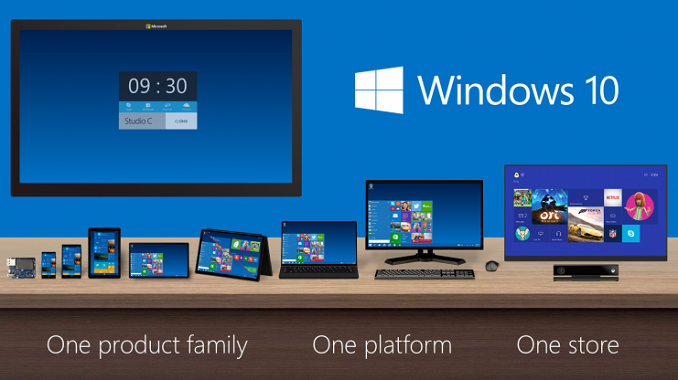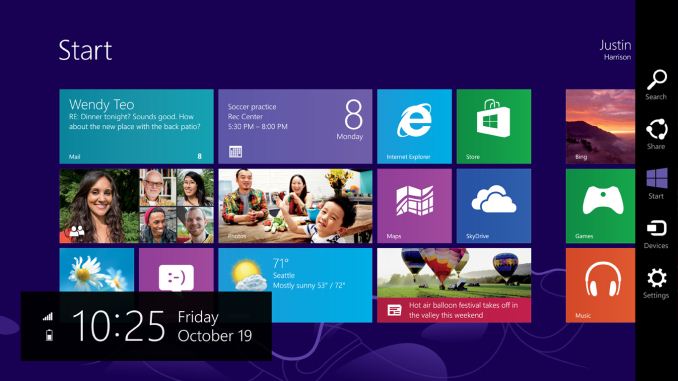Windows 10 Technical Preview First Impressions: The Return Of The Desktop
by Brett Howse on November 13, 2014 8:00 AM EST- Posted in
- Software
- Microsoft
- Windows 10

I’ve said this before, and I will reiterate it now. Windows 8, in general, is not perceived in a positive light. Not necessarily because of the lack of features, or even due to the touch first interface, but because from the start people did not buy into the paradigm. We can argue over why that was, and the specifics are likely different for every individual. But a big part of that was that Windows, which has had a familiar interface since Windows 95, had changed dramatically in look, feel, and general use. The traditional mouse and keyboard PC and notebook is a big part of the Windows user base, and especially at the beginning, Windows 8 did not cater to that crowd. While there were certainly improvements to the desktop, it was not enough to overcome the negative feelings of many users in regards to being productive on their PC. I say this as a fan of Windows 8.1, and I say this despite the positive review from this site. Windows 8 was an OS that worked, but had a steep learning curve that many people did not want to bother learning.
One of the biggest issues facing Windows 8 was just how much people liked Windows 7. Windows 7 was seen as the savior to Vista, and fixed many of its issues. But a lot of the initial problems with Vista were due to a major change in the driver model as well as the security model, which caused a lot of compatibility issues with older programs which expected administrator rights, as well as many hardware devices needed driver updates. With Windows 7, all of those changes were in the rear view mirror, allowing 7 to be a tweak of the overall UI and functionality rather than a rebuild of the OS from the ground up. With Windows 8, the move to touch first caused another dramatic upheaval. This time, rather than incompatible programs and hardware, we got a new Start Screen, a new runtime in WinRT, and a new app model with the Windows Store. For reasons that will never be made clear, the familiar start button was even removed, with the designers relying on hidden functions such as the hot corners to navigate around the OS with a mouse and keyboard. Luckily this change was reversed for Windows 8.1, with the start button returning, even if it still opened the Start Screen. With the Windows 8.1 Update, the system was made much more usable for a mouse and keyboard with the return of the menu bar to close apps, rather than dragging them down off the screen, and several other changes as well which brought the balance back somewhat to cover both touch interfaces as well as the mouse and keyboard.
 Windows 8 at launch in October 2012
Windows 8 at launch in October 2012
With Windows 8, Microsoft tried out an operating system which would work with a single interface across a breadth of hardware, from small form factor tablets, up to 30” monitor desktops. While they certainly succeeded in creating an interface that worked across all of those platforms, it was not ideally suited to any of them. With the tablet mode, the new Start Screen worked very well, and the charms menu and app switcher were fairly easy to use. But many of the settings and programs would be on the desktop, where touch only worked sparingly. Some desktop applications, such as Office, were created with a touch mode to increase the size of the onscreen elements, but overall the experience was subpar. Similarly, on the desktop, the touch interfaces were not ideal, and the hot corners certainly had issues especially on multi-monitor systems.
Windows 10 Technical Preview at launch
But now we come to Windows 10. Windows 10 is ditching the “One Interface to Rule them All” mentality, and moving to a more user friendly model of a single store across all platforms, and multiple interfaces to the same OS depending on the current usage model. We have not seen all of this in practice as of yet in the Technical Preview, but Microsoft has demonstrated their solution to this change in input mode with a feature they are calling Continuum.
The goal is that those that are on a keyboard and mouse based system will have the traditional start menu and desktop, with apps in windows, but if you are on a touch based device, or if you go on a 2-in-1 from keyboard to touch, the system will switch to the Windows 8 style start screen with full screen apps.
One of the keys to having this experience is an app model that allows a developer to target this different user interface paradigms. Microsoft’s solution to this is Universal Apps.











198 Comments
View All Comments
valnar - Monday, November 17, 2014 - link
I don't quite understand the Metro app thing on a desktop. It's a regression in every way. Single app, full screen, doesn't run in the background, etc. Yes, I know Apple does this with iOS but it works for a small device, small screen, and limited memory. On a desktop computer, running an app the way Microsoft designed Metro harkens it back to DOS days. It's called Windows, not Window. Glad they are finally fixing some of that in Windows 10.TinHat - Monday, November 17, 2014 - link
+1Ubercake - Monday, November 17, 2014 - link
Seems like Windows 10 is turning out to be everything Windows 8 was meant to be (ie Unified desktop) while incorporating customer feedback. Looks pretty good.Kutark - Monday, November 17, 2014 - link
Really wish they would at least give the option of enabling aero again. I know in the end its a relatively minor quibble, but i can't express in words how much i hate the stupid pastel themed title bars/windows, etc.Kutark - Monday, November 17, 2014 - link
I should also mention, while win10 looks like a nice step in the right direction, i still think they're going to get the shaft with gamers when steamos comes out (depending on developer support of course). I can honestly say that i've not once, literally not once, had a need or ever clicked, used, or looked at the stupid touch interface (whatever they call it) in months of using windows 8.1. I just need a desktop where i can put icons, a web browser, etc. I don't need "apps" ala a smartphone. If i do, i'll use my smartphone/tablet. Desktops are primarily for "serious business" and all this crap does is get in the way of your ability to efficiently use the system.That being said all the backend stuff in windows 8.1 is great. I will say it works well.
Che - Tuesday, November 18, 2014 - link
I am so in agreement with the above. It is killing me to give up aero. Everytime I see these pics of windows 10, or use windows 8/8.1 it just visually hurts.jrs77 - Tuesday, November 18, 2014 - link
I don't want something fancy for touch-screens and all these widgets, apps, etc.I'm using Windows only on my workstation and for that I need an OS that works with keyboard and mouse first and foremost.
Microsoft should'nt try to integrate all the devices but simply have one OS for mobile devices and one for dektop workstations.
R. Hunt - Tuesday, November 18, 2014 - link
This is still FrankensteinOS, and "Modern" apps look and feel like they were running on a mobile emulator rather than actual desktop applications. Sorry, not impressed, not really seeing how this is any different from Windows 8 or what the hype is all about. All I see is Microsoft still desperately trying to push Metro, their App Store, and associated services on desktop users.Techstedt - Tuesday, November 18, 2014 - link
"a lot"JackMenendez - Wednesday, November 19, 2014 - link
I don't know why it is so hard to understand Windows 8.x failure. There are different kinds of input for navigation and feedback to that input. The design of the UI should be optimum for the kind of input used. If you have a touch screen then a touch screen UI is probably what you are looking for; Windows 8.1 great. If you don't have a touch screen, then a mouse and/or keyboard input UI is what you are looking for; Windows 7 great. When Microsoft put a touch screen UI on a system with only mouse and keyboard input then it is not optimum; it is not what people want. Microsoft went one step further, they took away a UI optimized for mouse and keyboard and replaced it with a UI optimized for touch when most computers don't have touch. This move is called shooting the foot off.Someday, we will have a computer that understands speech so well that we won't need a navigation input. Kind of like the fictional computers on Star Trek. Will we put a touch UI on these? Will it be
"Computer, touch the start button then touch the sensors button, then touch the scan enemy ship button"
Or will it be
"Computer, Scan the enemy ship"?
One kind of UI for all things represents complete ignorance of how people use computers. Stack Exchange lists VIM as one of the most popular IDE's for writing code; for C++ VIM is as popular as Visual Studio. VIM, think about it. For some things touch and mouse are not as good as something developed in the early 1970's but Microsoft does not seem to get that.